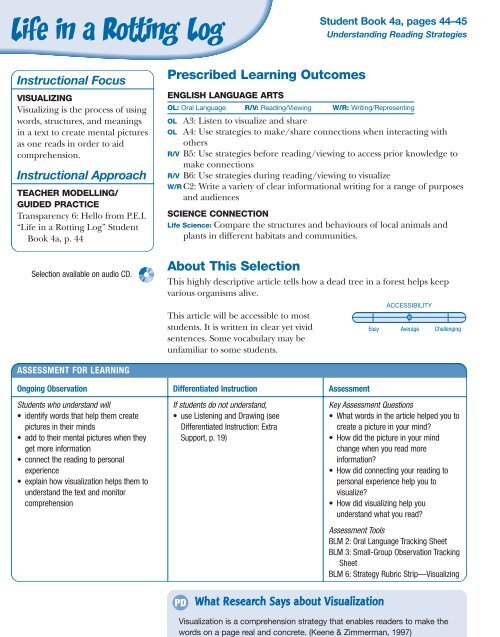Teacher's Resource - Nelson Education
Teacher's Resource - Nelson Education
Teacher's Resource - Nelson Education
Create successful ePaper yourself
Turn your PDF publications into a flip-book with our unique Google optimized e-Paper software.
Life in a Rotting Log<br />
Student Book 4a, pages 44–45<br />
Understanding Reading Strategies<br />
Instructional Focus<br />
VISUALIZING<br />
Visualizing is the process of using<br />
words, structures, and meanings<br />
in a text to create mental pictures<br />
as one reads in order to aid<br />
comprehension.<br />
Instructional Approach<br />
TEACHER MODELLING/<br />
GUIDED PRACTICE<br />
Transparency 6: Hello from P.E.I.<br />
“Life in a Rotting Log” Student<br />
Book 4a, p. 44<br />
Selection available on audio CD.<br />
Prescribed Learning Outcomes<br />
ENGLISH LANGUAGE ARTS<br />
OL: Oral Language R/V: Reading/Viewing W/R: Writing/Representing<br />
OL A3: Listen to visualize and share<br />
OL<br />
A4: Use strategies to make/share connections when interacting with<br />
others<br />
R/V B5: Use strategies before reading/viewing to access prior knowledge to<br />
make connections<br />
R/V B6: Use strategies during reading/viewing to visualize<br />
W/R C2: Write a variety of clear informational writing for a range of purposes<br />
and audiences<br />
SCIENCE CONNECTION<br />
Life Science: Compare the structures and behaviours of local animals and<br />
plants in different habitats and communities.<br />
About This Selection<br />
This highly descriptive article tells how a dead tree in a forest helps keep<br />
various organisms alive.<br />
This article will be accessible to most<br />
students. It is written in clear yet vivid<br />
sentences. Some vocabulary may be<br />
unfamiliar to some students.<br />
ACCESSIBILITY<br />
Easy Average Challenging<br />
ASSESSMENT FOR LEARNING<br />
Ongoing Observation<br />
Students who understand will<br />
• identify words that help them create<br />
pictures in their minds<br />
• add to their mental pictures when they<br />
get more information<br />
• connect the reading to personal<br />
experience<br />
• explain how visualization helps them to<br />
understand the text and monitor<br />
comprehension<br />
Differentiated Instruction<br />
If students do not understand,<br />
• use Listening and Drawing (see<br />
Differentiated Instruction: Extra<br />
Support, p. 19)<br />
Assessment<br />
Key Assessment Questions<br />
• What words in the article helped you to<br />
create a picture in your mind<br />
• How did the picture in your mind<br />
change when you read more<br />
information<br />
• How did connecting your reading to<br />
personal experience help you to<br />
visualize<br />
• How did visualizing help you<br />
understand what you read<br />
Assessment Tools<br />
BLM 2: Oral Language Tracking Sheet<br />
BLM 3: Small-Group Observation Tracking<br />
Sheet<br />
BLM 6: Strategy Rubric Strip—Visualizing<br />
What Research Says about Visualization<br />
Visualization is a comprehension strategy that enables readers to make the<br />
words on a page real and concrete. (Keene & Zimmerman, 1997)<br />
NEL Life in a Rotting Log 17

















